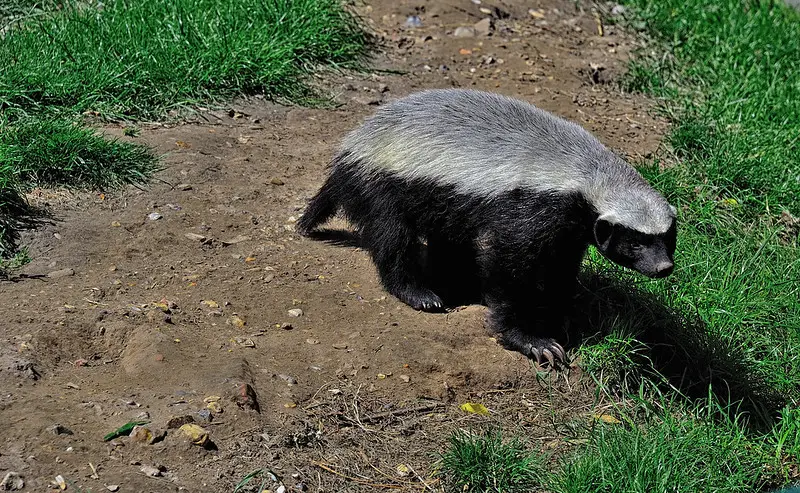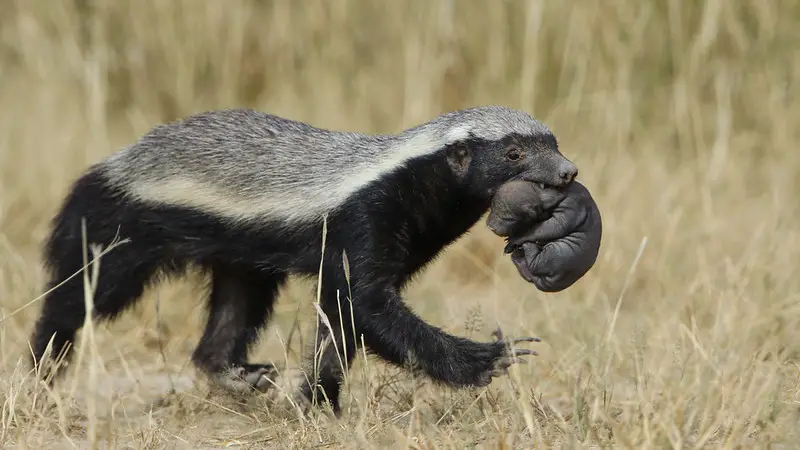Honey badgers have long captivated the world with their tenacity and fearlessness. Found primarily in Africa and Southwest Asia, they are known as one of the most fearless animals on earth. But why exactly do we call them honey badgers?
The honey badger has been renowned for its toughness since ancient times. It is an adaptable species that live in various habitats, including deserts, woodlands, savannas, scrub forests, mountains, grasslands, and even urban areas. Its diet consists mostly of small mammals such as rodents, reptiles, amphibians, and birds, but it also scavenges for carrion when available. Honey badgers will even go after larger prey, such as antelope or wild pigs, if necessary. Despite their size (about two feet long), they can easily overpower other predators due to their agility and strength.
In addition to being tough survivors in nature, honey badgers have become iconic symbols of courage and resilience among humans. They’ve been featured in popular media, from Disney films to YouTube videos – inspiring us all with messages about never giving up despite seemingly insurmountable odds. So how did these fascinating creatures come to be called ‘honey badgers’? The answer lies in their appearance and the intriguing behaviors that make them so unique among carnivores.

The Origin Of The Name
The honey badger is an animal native to Africa, India, and the Middle East. It has garnered notoriety for its tenacity and fearlessness regarding predators. This has led some people to wonder why this animal is called a “honey badger.” The answer lies in a combination of factors related to the creature’s behavior and biology.
Honey badgers have been known to consume honeycomb from beehives and beeswax as part of their diet. They will also hunt small animals around these hives, such as rodents or lizards. Additionally, they are noted for their strong sense of smell, primarily for locating food sources such as bee larvae or grubs in logs. Their thick coats protect against stings by bees or wasps while they search for food items near beehives. Finally, their distinctive black-and-white stripes may serve as a warning sign that warns other creatures away from the potential danger posed by the honey badger’s aggressiveness towards intruders on its territory. All these factors likely contributed to giving them the name ‘honey badger.’
Thus, it can be seen that the name ‘honey badger’ serves as an apt descriptor for the animal due to both its unique behaviors and physical features. Its ability to obtain food from beehives combined with its protective coat and signature striped pattern resulted in this moniker being assigned to one of nature’s most fearless predators.
How dangerous are honey badgers? You might be surprised
Physical Characteristics Of Honey Badgers
Honey badgers have several physical characteristics that set them apart from other animals in the animal kingdom. They are relatively small mammals, measuring between 24-30 inches (60 – 80 cm) and weighing up to 25 pounds (11 kg). Honey badgers have long bodies with short legs, a wide head, and powerful jaws capable of crushing bones. Their fur is blackish-brown on top and yellow underneath, giving them their common name.
The honey badger also has remarkable strength for its size; it can drag prey three times its weight. It also has extremely tough skin covered in thick hairs, making it difficult for predators to attack or even penetrate the hide. This coating helps protect the honey badger from bee stings and bites from snakes or other large predators. The unique coloration serves as camouflage while hunting; they blend into their surroundings, making them less visible to potential prey and attackers alike.
Due to their ability to adapt quickly and effectively to various environments, honey badgers have survived successfully in dry grasslands, forests, deserts, mountain ranges, and scrubland habitats across Africa and Asia. Furthermore, their impressive physical traits make them formidable hunters who take down virtually any prey regardless of size or species—from insects to larger mammals like antelopes or wild boars.
Do you know what the predators of honey badgers are? Find out here
Adaptations
Honey badgers, also known as Ratels, have evolved a suite of adaptations that allow them to survive in their environment. One adaptation is their sharp claws which they use for digging and tearing apart beehives or termite mounds. Their powerful jaws are also adapted to crack open the shells of tortoises, hedgehogs, and other small animals. These traits make them successful predators and scavengers who can feed on carrion.
The honey badger’s diet consists mainly of insects, larvae, crabs, frogs, lizards, snakes, birds, eggs, and young chicks, but they will also eat fruit if available. Additionally, its thick skin protects from bites and stings from bees and other creatures when it raids hives for honey. They can also move quickly through dense vegetation due to their short legs and low center of gravity. Moreover, this species has an incredible sense of smell, allowing them to detect food sources both above ground and underground.
This animal’s ability to adapt has enabled it to live in a wide range of habitats throughout Africa and Asia, including deserts, forests, grasslands, and wetlands, where it is often seen near waterholes or along riverbanks looking for prey such as fish or amphibians. Honey badgers are highly resilient animals with few natural predators except humans, who hunt them for fur or meat. This remarkable species continues to thrive despite human interference demonstrating its evolutionary success over time.
Honey badgers are extremely tough animals. Find out about their adaptations here
Behavior
Honey badgers are known for their aggressive and fearless behavior, which is deeply rooted in their evolutionary adaptations. A variety of traits, such as boldness, aggression, tenacity, and resourcefulness, can characterize their behavior. Honey badgers have powerful jaws with long sharp claws that allow them to dig into burrows and dens to hunt their prey. They also have strong front legs for digging, climbing trees, and defending themselves against predators.
When it comes to hunting or scavenging food, honey badgers are particularly opportunistic animals; they will not hesitate to take advantage of any available resources. In addition to being an effective hunter, the honey badger is also an excellent scavenger–they often raid other animals’ nests or caches looking for food. This type of behavior has earned them a reputation as formidable bandits amongst both humans and wildlife alike. Furthermore, when threatened or provoked, these animals will fiercely defend themselves using their sharp teeth and claws.
Given its assertive attitude towards danger and its tendency to use whatever resources necessary for survival, it’s no surprise why some people call the honey badger “the most fearless animal on Earth.” This combination of behaviors—boldness, aggression, tenacity, and resourcefulness—makes the honey badger one of nature’s toughest creatures in the wild today.
The Relationship Between Honey Badgers And Honey
The relationship between honey badgers and honey is very interesting to animal biologists. Honey badgers, also known as ratels, are found in parts of Africa, the Middle East, and India. These animals get their name from their fondness for consuming bee larvae and honeycomb. In addition to being an important source of nutrition, this behavior has helped them earn a reputation as one of the most fearless predators on the continent.
Honey badgers have adapted to consume honey without risking injury from stings or bites by bees. They possess loose skin that allows them to slip out of the grasp of attacking insects, which provides some protection against harm during foraging for sweet treats. Additionally, they can use their sharp claws to easily break into beehives and quickly lick up any spilled contents around them. As such, these creatures play a crucial role in regulating local bee populations while simultaneously providing themselves with sustenance.
Compared to other animals that feed on honeycomb or bee larvae, such as bears or gorillas, honey badgers exhibit far less damage when accessing hives due to their agile movements and specialized anatomical features that enable them to access food sources more efficiently than larger species would be able. This combination of factors makes them uniquely suited for taking advantage of available resources at minimal cost – for themselves and other wildlife species in the region.
Do you know what the predators of honey badgers are? Find out here
Diet
Honey badgers are omnivorous animals, meaning they partake in plant and animal matter as part of their diet. They feast on rodents, reptiles, ground-nesting birds, insects, frogs, and tubers. Honey is also a popular item for honey badgers to consume. As such, it can be assumed that the reason why this species is referred to as ‘honey badger’ may come from its tendency to seek out honey as a food source.
In addition to these items mentioned above, honey badgers love raiding bee nests for the sweet liquid found inside them. This behavior has been observed across several African countries, including Zambia and Botswana; however, it is unlikely that the name ‘honey badger’ comes from this activity alone since not all populations engage in this behavior. Nevertheless, it could have played an important role in coining the phrase due to its familiarity in certain areas where beekeeping practices were commonplace.
Given the dietary habits of honey badgers, it would appear that their moniker likely originated based on their preference for consuming honey or other sugary substances available around bee hives. Consuming high amounts of sugar provides them with enough energy to survive in harsh climates while pursuing other sources of nutrition, like rodents or ground-dwelling creatures. Thus, understanding the specifics behind their diet may provide further insight into why they are called ‘honey badgers.’
Interactions With Humans
Honey badgers are known for their fearless nature, which has made them a regular subject of internet memes. Their interactions with humans are an important part of understanding this species. In general, honey badgers prefer to avoid contact with people and will usually try to flee from any interaction. However, if they feel threatened or cornered, they can become aggressive and fight back in defense.
In areas where human populations overlap with the range of honey badger habitats, it’s not uncommon for these animals to raid crops, feed on livestock carcasses, and even steal chickens from henhouses. This behavior often leads to conflicts between local farmers and honey badgers that could be avoided by using appropriate measures such as using electric fences or guarding dogs around vulnerable farmlands.
Despite these potential conflicts over resources, some cultures have adopted honey badgers as spiritual figures or totems due to their strength and courage. For example, traditional healers in Zimbabwe use parts of the animal’s body for ritual purposes, while other African tribes consider honey badgers sacred animals associated with fertility deities.
How dangerous are honey badgers? You might be surprised

Range And Habitat
Honey badgers have a vast range, covering much of sub-Saharan Africa and extending into parts of southwest Asia. The species is widely distributed in Ethiopia, Somalia, Tanzania, Kenya, South Africa, Namibia, Botswana, Angola, Zimbabwe, and Mozambique. It has also been reported from Cameroon, Nigeria, Saudi Arabia, and Yemen.
The honey badger inhabits both open savannahs and more closed habitats, such as forests with dense brushwood or rocky areas with caves where they can take refuge when threatened. They are found at altitudes up to 5500 m in dry arid regions, including semi-deserts and tropical rainforests near watercourses. Honey badgers may occasionally hunt within cultivated land. However, this appears to be an unusual activity for them, given their preference for natural habitats that offer covers such as trees or thickets.
In terms of population, density estimates vary greatly from 0.2 – 18 individuals per km² across different regions, making it difficult to accurately gauge numbers globally due to its wide-ranging habitat preferences combined with potential variation in local abundance levels depending upon environmental factors like seasonality and availability of food sources.

